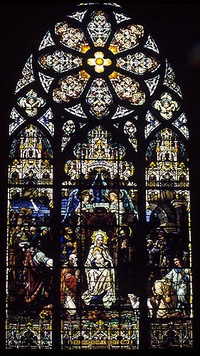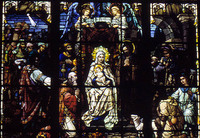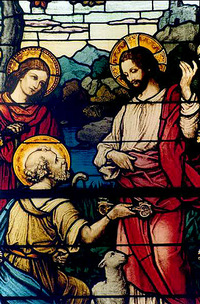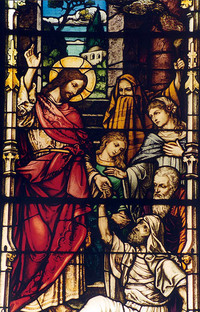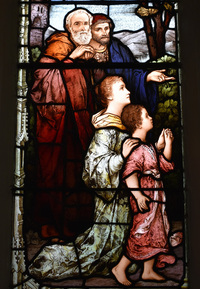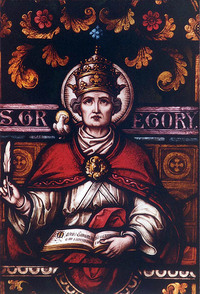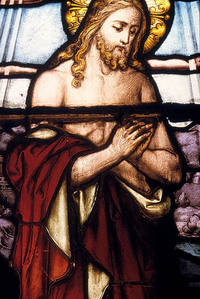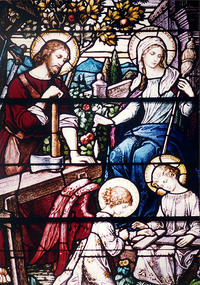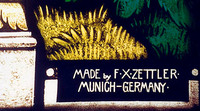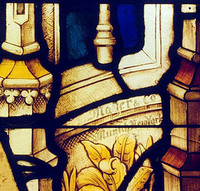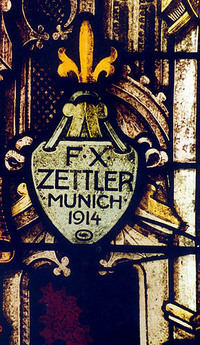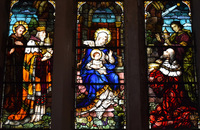Featured Windows, January-February 2008
The Cathedral of St. Andrew, Grand Rapids and the Munich Pictorial Style in Michigan's Stained Glass
Buildings:
St. Andrew Cathedral (and St. Ambrose Chapel) - Grand Rapids, Michigan
Holy Rosary Church - Cedar, Michigan
Cathedral of St. Paul - Detroit, Michigan
Christ Church Detroit - Detroit, Michigan
St. Boniface Catholic Church (closed 1989) - Detroit, Michigan
Spirit of Hope - Detroit, Michigan
St. Michael. Unknown maker, 1876. Cathedral of St. Andrew, Grand Rapids, MI. MSGC 95.0028. Photo by Thomas R. Bochniak. This St. Michael window is one of several windows that survived St. Andrew's fire of 1901. Between 1850 and 1870 the Catholic population in Grand Rapids had grown nearly tenfold, thanks in large part to an influx of German and Irish immigrants. The new parish was intended chiefly to serve the growing Irish Catholic community.3 Part of the new foundation was formed from the limestone of the "old stone church" on Monroe Street that once housed St. Andrew's.4 It was, at that time, the largest building in the city. According to John McGee, a large number of stained glass windows in "the multifoil style" were installed,5 but most of them were lost in a church fire in March of 1901, replaced with "imported" windows "in the period from 1903 to 1920."6 It was decided that the church should be partially torn down, redesigned and enlarged to accommodate its growing population. The Milwaukee firm of Erhard Brielmaier and Sons was chosen to complete the task, with work beginning on July 12, 1901. At the time, prism glass was set into the windows, where stained glass would replace it at a later date.7
Left: "The Giving of the Keys to Peter" (detail). Attributed to Franz Mayer & Co., ca. 1915. Cathedral of St. Andrew, Grand Rapids, MI. MSGC 95.0028. Photo by Thomas R. Bochniak. Right: "The Raising of Lazarus (detail)." Attributed to Franz Mayer & Co., ca. 1915. Cathedral of St. Andrew, Grand Rapids, MI. MSGC 95.0028. Photo by Thomas R. Bochniak. "Presentation of the Child Jesus in the Temple" (detail). F.X. Zettler, Munich, 1914. Cathedral of St. Andrew, Grand Rapids, MI. MSGC 95.0028. Photo by Thomas R. Bochniak. McGee indicates that this window was purchased at a price of $400.8 The new windows in the church were completed by the affiliated studios of Franz Mayer and F.X. Zettler of Munich. Identification of specific windows in St. Andrew's is somewhat confusing, as it appears that both Mayer and Zettler were working at the same time (possibly together), and not every window bears a signature. The Presentation window bears a large 1914 signature by Zettler and two windows (Flight into Egypt, ca. 1912-13 and the Baptism of Christ, ca. 1915) bear two different styles of Mayer signatures. Additionally, while McGee attributes the large ca. 1912 Nativity window to Mayer, the window bears Zettler's disctinctive signature shield on its left lancet. The windows were clearly all designed to integrate together very well and feature similar ornamental details, although variations in the painting styles of figures is discernable. It is unclear whether the Mayer and Zettler studios were working at St. Andrew's simultaneously on the over two dozen windows produced during this period or whether one firm was working as subcontractor to the other.9 Mayer and Zettler worked in the popular "Munich pictorial style" of stained glass10 that appeared in many American churches in the late nineteenth and early twentieth centuries. The style developed out of the Royal Bavarian Stained Glass Establishment (Konigliche Glasmalereianstalt) in 1827 under Ludwig I of Bavaria. Other Munich or Munich-style firms of the time included Tiroler Glasmalereianstalt (Innsbruck, Austria), van Treeck (Munich), Fred Müller (Quinlinberg), Gassen & Blaschke (Düsseldorf) and George Boos (Munich), although the style's popularity led to its adoption by many non-German studios as well.11 With regard to windows identified in Michigan as "Munich Style," we are primarily referring to works by Mayer and Zettler, although additional buildings from this period have been identified with windows by Tyrolean Stained Glass (Tiroler Glasmalereianstalt) and other German studios. There are fourteen buildings in Michigan with windows attributed to Mayer & Co. of Munich, and six with windows attributed to F.X. Zettler. These buildings can be found in communities both large and small. Left: "Suffer the Little Children to Come Unto Me" (detail). Franz Mayer & Co., 1905. Christ (Episcopal) Church, Detroit, MI. MSGC 93.0109. Photo by Josephine Zedan. Probably one of the most notable Mayer windows to be found in the state would be the "Lyster Window" from Christ Church, Detroit. The tri-lancet scene with a central figure of Christ features figures painted from the likenesses of the family of Dr. Francis Lyster, donor of the window. The elder male figure here represents William Narcissus Lyster, the first rector of Christ Church. Francis Lyster is next to him.12 Right: Nativity Window (detail). Franz Mayer & Co., date unknown. Cathedral Church of St. Paul (Episcopal, built 1911), Detroit, MI. MSGC 93.0096. Photo courtesy of Nola Tutag. The imagery of the Munich style is derived from the Nazarene school of German and Austrian painters. The Nazarenes were inspired by the master painters of the Italian Renaissance. Like the Nazarenes, the Munich-style stained glass artists sought to convey moral truths through their art. As Jean Farnsworth notes, " A typical Munich pictorial window encourages emotional contact with the sacred stories." Munich style windows are recognizable and respected for their elaborate, finely executed painting. The figures are finely modeled, expressive and idealized, while a sense of dimension created by ornate, architectural canopies and other effects visually "invite" the viewer into the scene.13 Frueh notes that in Munich compositions, the leadlines are "subordinate" to the painted surface.14 Left: St. Gregory the Great. Franz Mayer & Co., ca. 1906. St. Boniface Catholic Church (closed 1989), Detroit, MI. MSGC 93.0112. Photo by William M. Worden. A 1906 Detroit newspaper article announcing the installation of several new windows at St. Boniface stated: "Mayer & Co. of Munich are the designers and makers of the new windows, that firm being considered the leader in this line of work. The coloring is rich without being gaudy and the faces are expressive and beautiful."15 Right: "Baptism of Christ" (detail). Franz Mayer & Co., 1892. Trinity Episcopal Church, Detroit, MI. MSGC 93.0162. Photo by Barbara Krueger. Founded in 1847-48 by Josef Gabriel Mayer (1808-83), the firm of (Franz) Mayer & Company originally produced ecclesiastical furnishings, contracting its stained glass work to local artists in Munich. Mayer's sons Joseph (1846-98) and Franz (1848-1926) were also involved in the company's operations, as have been subsequent generations, to this day. In 1863 Franz Xaver Zettler (1841-1916) joined the firm as art director and married J.G. Mayer's daughter Therese shortly thereafter. The stained glass department was established under Zettler's supervision in 1865.16 Zettler formed his own studio in 1870, the Institute of Eccleastical Stained Glass windows, which was represented in the United States through the Daprato Statuary Company of Chicago and New York. Zettler also sold his windows through the Swiss firm of Benziger Brothers. Mayer established an American branch in New York in 1888 and while Farnsworth notes that although Zettler is said to have had American offices for his studios, addresses have not been identified for them. The Mayer and Zettler firms joined in 1939.17 The cachet for American clients of having windows from European studios is evident even today as we try to retrace the provenance of windows from both American and European makers. An attribution we encounter occasionally from churches is that of windows originating from "Munich" or "Germany." While this is no doubt plausible from the visual attributes of many windows, documentation itself often does not survive in any form other than in church lore. While there are many unsigned windows in Michigan that are absolutely painted in what could be described as the Munich style, without signatures or documentation of provenance there is no way of confirm whether the windows came from German makers, or from any number of American contemporaries who were working in the popular style and employing their own German-born and trained glass painters. Holy Family Window (detail). F.X. Zettler, 1925. Holy Rosary Church, Cedar, MI. MSGC 95.0072. Photo courtesy of Leona Witkowski, Pamela Lieurance and Pam Novak. We should note that the Munich pictorial style is not to everyone's taste, and it certainly has had its detractors over the years. Frueh remarks that some find the subject matter overly sentimental,18 while James Sturm notes that critics of the style find it overly embellished and sometimes poorly executed on a technical level. Simply viewing the several examples of windows we have shown here, we can see the hand of different painters at work and, consequently, the variation in skill between them.19 Whatever our individual tastes may be, or the technical merits or flaws of particular windows, the fact remains that this work is found in many fine churches and cathedrals around the world for a reason. It represents an aesthetic that was evidently prized in its time for its craftsmanship and opulance as well as for its ability to engage the viewer emotionally and spiritually. Several signatures found on Mayer and Zettler windows in Michigan churches.20 Notes: 1McGee, John Whalen. The Catholic Church in the Grand River Valley, 1833-1950. Grand Rapids, MI: [s.n.], 1950, p. 30. 2The history of the Catholic church in the Grand Rapids area as it relates to early settlement of the region is recounted in excellent detail in McGee, especially chapters 2-3. 3McGee, pp. 205-6. 4ibid., p. 208. 5ibid., p. 219. McGee notes the windows' dedication and all of the donors' names, apparently quoted from The Grand Rapids Enquirer's account of the church dedication from December 20, 1876. 6ibid., p. 217. McGee does not indicate who the maker of the original windows was. Several old windows survived the fire, including a rose window, a window of St. Matthew, and windows of the archangels Raphael and Gabriel. ibid., p. 278. 7ibid., pp. 274-6. 8ibid., p. 297. 9In addition to the 1876 unidentified windows and the windows by Mayer and Zettler, St. Andrew's also has a series of contemporary windows completed for its St. Ambrose Chapel in 1963-64 by Byron White of Grand Rapids Art Glass. 10Farnsworth, Jean M. "Biographical Sketches of Stained-Glass Studios and Selected Artists," in Farnsworth, Jean M., Carmen R. Croce, and Joseph F. Chorpenning. Stained Glass in Catholic Philadelphia. Philadelphia: Saint Joseph's University Press, 2002: 441; 457. 11Farnsworth, Jean M. "Stained Glass in the Philadelphia Archdiocese: Reflections of Faith and Culture," in Farnsworth, Jean M., Carmen R. Croce, and Joseph F. Chorpenning. Stained Glass in Catholic Philadelphia. Philadelphia: Saint Joseph's University Press, 2002:135. Jean Farnsworth's excellent discussion of the Munich pictorial style reveals how the Catholic church was influential in its support and proliferation in American churches during this period. There are certainly examples of Munich style windows in some of Michigan's finest older Catholic churches and cathedrals, although they can be found in churches of other denominations, particularly Episcopalian. 12Tutag, Nola Huse with Lucy Hamilton. Discovering Stained Glass in Detroit. Detroit: Wayne State University Press, 1987, p. 49. 13Farnsworth, p. 137. 14Frueh, Erne R., Florence Frueh, and George Lane. Chicago Stained Glass. Chicago: Loyola University Press, 1983, p. 112. 15"Three Beautiful Scenes From the Life of Christ." Detroit Free Press. 21 March, 1906. 16Farnsworth, p. 441. 17ibid., pp.146, 441, 457. 18Frueh, p. 110. 19Sturm, James L. Stained Glass from Medieval Times to the Present: Treasures to be Seen in New York. New York: Dutton, 1982, p. 33. 20While we have encountered numerous unsigned windows in the "Munich style" around Michigan, Mayer signatures seem to be fairly common, if not consistently applied. Variations on Mayer signatures included: Franz Mayer & Co., F. Mayer & Co., Franz Mayer of Munich, F. Mayer of Munich, Mayer of Munich, and Mayer & Co. These variations also could have included the addition of the cities of Munich, New York, London or Chicago. There is no record as to a pattern or chronology in which the variations occurred. Current opinion is that multiple representatives managing different orders from multiple offices may have influenced this, although there is no apparent way to document this easily. Nearly all of the early Munich records of Mayer were destroyed in 1944 and all of the London records are lost, although efforts are being made at present to digitize the early American records that remain. E-mail from Wilifried Jaekel to Barbara Krueger. 26 February 2007. Michigan Stained Glass Census file 98.0052, Michigan State University Museum, East Lansing, Michigan. The signed Zettler windows we have seen in Michigan have simply been signed F.X Zettler Munich (or Munich, Germany), although Zettler windows in Philadelphia have been marked with the name Royal Bavarian Institute for Stained Glass. Perhaps other variations exist as with Mayer. Farnsworth, p. 457.
Bibliography: Show Bibliography
(MSGC 1995.0072, 1993.0109, 1995.0028, 1993.0096, 1993.0112, 1993.0162)
Text by Michele Beltran, Michigan Stained Glass Census, January , 2008.

